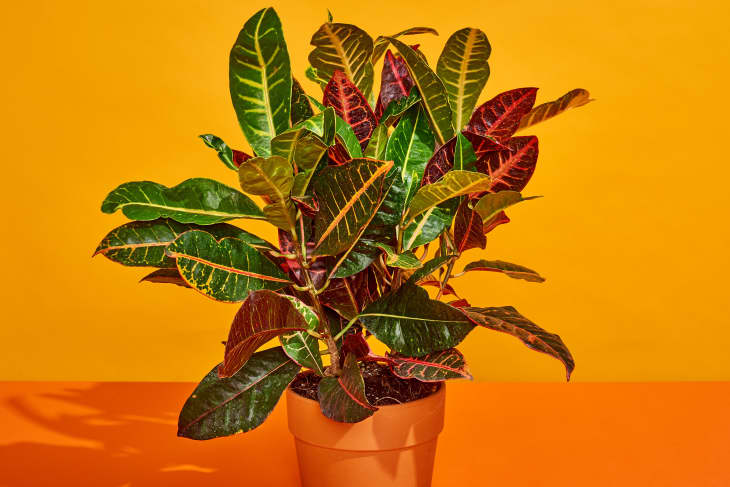
People love the dramatic yellow, orange, silver, red, white —or even black — multi-colored leaves of croton plants, but don’t know they can also be quite challenging to grow. When I asked about them at a local plant shop, they said that they don’t even carry them because they tend to drop their leaves during transport, so you may need to hunt around to find them. Once you do, you have to really know what you’re doing to keep this diva of a plant happy. But, if you think you’re up to the challenge, here’s a croton cheatsheet.

About This Plant
Codiaeum variegatum, or variegated croton, is an evergreen shrub in its native lands of Indonesia, Australia, Malaysia, and Pacific Ocean islands. Hundreds of cultivars sport a wide variety of leaf shapes, colors, and patterns, so you can probably find one to match your decor if you’re so inclined.
The ASPCA doesn’t have an entry about croton toxicity, but other sources indicate that it’s likely toxic to dogs and cats, and people. Even broken branches or leaves produce an irritating sap that can cause eczema, and reportedly tastes terrible, fortunately discouraging further consumption. Parents with young children will probably want to skip this plant.

Where to Grow
Although they can grow outdoors in tropical climates where temperatures don’t drop below about 50° F (10° C) in the winter, most of us will be growing our crotons indoors. They prefer to be kept at about 70° F (21° C), and need a spot with no drafts, and lots of bright light. If they don’t get enough light, they will get leggy, and their signature colorful leaves may fade.

Like most houseplants, crotons appreciate humidity. A kitchen or bathroom may be the best place for this plant, but if you can’t manage that, misting the leaves or a pebble tray can help keep the foliage properly hydrated.

Care and Planting
There are multiple reasons this plant’s leaves drop, which are what make this type tough to grow. The trickiest part of keeping a croton happy is watering correctly. Crotons will drop their leaves if given too much, or too little, water (or if the temperature is too low). They need their soil to be kept evenly moist, but not soggy. Don’t let the soil dry out completely before watering again, but plant in a pot with drainage, to prevent root-rot.
If you need to re-pot your croton, proceed with caution. The best time to do it is mid-to-late spring. Try to use a potting soil similar to the one the plant is already in, and don’t be surprised if you see mass leaf drop a few weeks after re-potting. Lastly, to avoid potential skin irritation from its sap, be sure to wash your hands after handling the plant.
These fast-growing plants need fertilizer once a month during the spring and summer growing seasons. An all-purpose houseplant fertilizer will work just fine.
How to Propagate
Crotons can be propagated from leaf cuttings, which involves cutting a stem a few inches long, dipping the end in rooting hormone, and pushing the end into potting soil. Like adult plants, the cuttings need moist soil and warmth, and keeping the soil at between 77° to 86° F (25° to 30° C) will increase your likelihood of success.
Hải Yến
Gió bạn với cây tự buổi nào ,
Gió về cây lại ngất ngư chao .
Gió đi cây sẽ im lìm đứng,
Như kẻ lỡ làng dạ khát khao .



